How an Art History Teacher Solved Two of the Biggest Mysteries about Van Gogh using Genealogical skills
The subject of the Art Crime/Mystery in this post is Vincent van Gogh who has been very much in the forefront of minds in Victoria this year as the exhibition Van Gogh at The Lume attracts attention.
Most people love his paintings and are enthralled by the 360 Digital Experience. And over coffee the discussion ranges far and wide as there is so much controversy surrounding Vincent's life not least of which is that in his short life he created over 2000 paintings of which 85 are recorded as missing or in unknown locations. But the conversation invariably turns to:
Did he really cut off his ear and send it to a prostitute?
In 1888, Van Gogh moved to Arles in the south of France and rented the Yellow House as shown in his painting below.
At Van Gogh's invitation, Paul Gauguin arrived in Arles in October 1888. The two painted side by side in the Yellow House for nearly nine weeks. Their relationship was sometimes companionable but often volatile, with Gauguin frequently on the verge of returning to Paris. Matters came to a head on December 23 when the two men quarreled, and Van Gogh ended up with a severed ear and a trip to a nearby mental institution.1
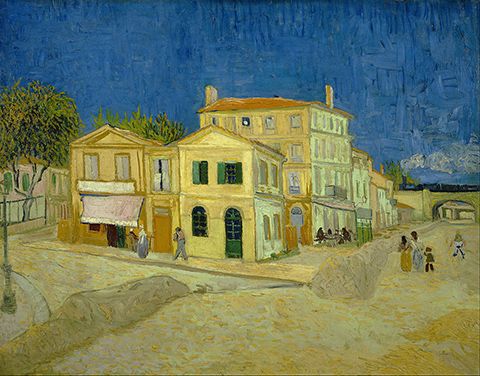
Gauguin, the witness, had two versions of what happened on that night which were discovered by a teacher of art history, Bernadette Murphy, who went on a mission to discover the truth behind the ear incident.
Murphy discovered the Van Gogh Museum’s official statement read that van Gogh cut off part of his left ear with a razor that day. A competing account from two German art historians in 2009 argued instead that Gauguin actually lopped off his colleague’s earlobe with a sword during a heated argument.3
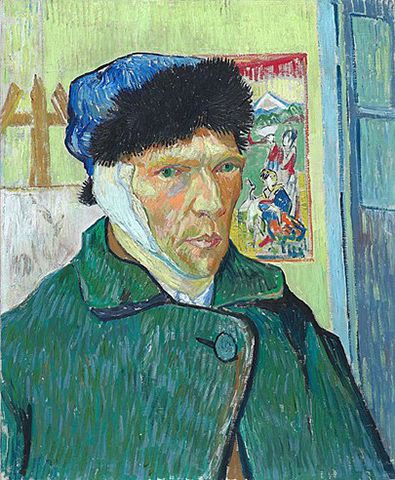
Back in 2009 Bernadette Murphy, an Art History teacher, was living just a few hours from Arles in France and on leave due to a health problem. She had always been fascinated with the story of Vincent's ear so with time on her hands she began to search for the answer.
The story of Bernadette's research was written up by Abigail Cain for artsy.net and a link to the article is given at the end of this post.5
It all started for Murphy with a nagging question: How much of his own ear did Vincent van Gogh actually cut off?...But the more she dug, the more questions she had: Who was the prostitute to whom van Gogh supposedly gifted his severed ear? 5
And also:
While travelling to Arles, why did the painter catch a train that dropped him off ten miles from his destination when he was weighed down with supplies?5
It was these “bits and pieces,” Murphy told Artsy, “that led me into looking at the whole story again like a detective might. The whole point was to take nothing as fact—to play the devil's advocate and go over the story all over again.” 5
Murphy took an unconventional approach to her research and ignored all the existing texts on the subject.
Her search began at the scene of the crime. But the archive in Arles contained only a handful of documents relating directly to the French painter’s life. There were no police reports of the ear incident, no records of van Gogh renting a house; there wasn’t even census data from 1891.5
But Bernadette had a skill she had learnt when researching her Irish ancestry which anyone who has tried to do this knows is incredibly difficult: Bernadette knew how to compile a database of each person in her family tree.
She decided to apply the same approach to Arles, beginning with the individuals who resided in van Gogh’s neighborhood when the fateful ear-lopping occurred. To date (2009 when the article was published), Murphy has gathered records on more than 15,000 people. They range from van Gogh’s cleaning lady to the town’s Protestant pastor.5
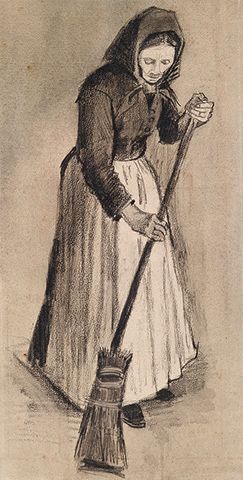
But there was another problem: Arles today bears little resemblance to the Arles van Gogh knew. An Allied bombing of the French village during World War II was followed by an extensive rebuilding program. So Murphy and an advising architect combed through old maps, land registries, and rare early photographs, eventually reconstructing a detailed map of pre-war Arles.5
These initial steps provided an essential foundation for the project. But the most fateful clue in Murphy’s inquiry was the discovery of a small slip of paper, not much bigger than her hand. She was led there by an unlikely string of documents that spanned continents—a trail that ended in Berkeley, California, where the archive of novelist Irving Stone can be found.5 Stone authored Lust for Life, the 1934 fictionalized biography of van Gogh.
You can read all the details about the search for a small slip of paper by following the link to the article at the end of the post. In summary, the breakthrough for Bernadette Murphy came from remembering the narrative surrounding the fateful night and finding a note in the Amsterdam archive where reference was made to the role played by one Félix Rey who had drawn a diagram for Irving Stone detailing Vincent's accident.
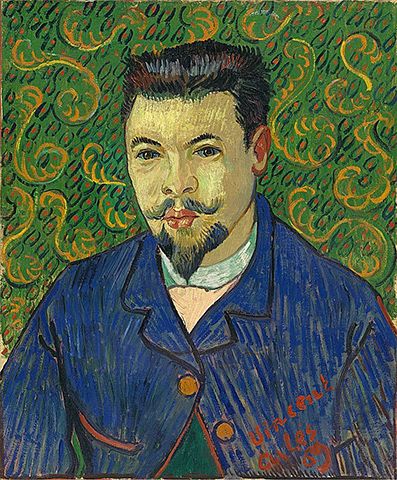
Murphy recognized the name immediately: Rey was the first person to treat van Gogh when he arrived at the hospital in Arles. She reread the sentence again and again. “Oh my God,” she recalled thinking. “If that document still exists, I have to find it.” 5
Eventually the Stone's archivist found the slip of paper and Dr Rye's diagrams detailing exactly where van Gogh had sliced his ear.5
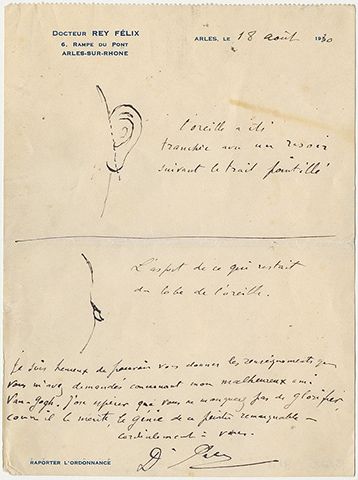
You can see for yourself how much of Vincent's ear was taken off.
Murphy also identified the girl to whom van Gogh gave his ear, yet another mystery in the artist’s biography that had stumped historians for over a century. Long assumed to be a prostitute named Rachel, it turns out that she was actually a maid in a brothel whose given name was Gabrielle Berlatier.5
Perhaps the most surprising part of the story, however, was Murphy’s initial attitude towards van Gogh. “I hope it doesn’t shock people to say that I didn’t particularly like van Gogh. He was a bit ‘old hat’ to me,” she said. “But as the story goes on and you read his letters and think about how he was struggling with mental illness, you become attached to the man. How could you not?”5
Vincent van Gogh's Self-Portrait with Bandaged Ear painted in oil on canvas in 1889 now hangs in the Courtauld Galleries. I'm off to the UK in July and I have this Gallery on my list of places to visit.
If you would like to read the article by Abigail Cain Please Click Here.
I have also learnt that Bernadette Murphy has published a book on her research: Van Gogh's Ear The True Story which is available online.
Finally, you can watch Bernadette Murphy in a Youtube video talking about the ear incident from Gauguin's perspective. The video is long taking nearly 60 minutes but well worth watching if you have time.
Credits
1. vincentvangogh.org
2. commons.wikimedia.org
3. artsy.net
4. en.wikipedia.org
5. Abigail Cain, How One Art History Teacher Solved Two of the Biggest Mysteries about Van Gogh, 26 July, 2016, artsy.net.
6. fineartamerica.com

